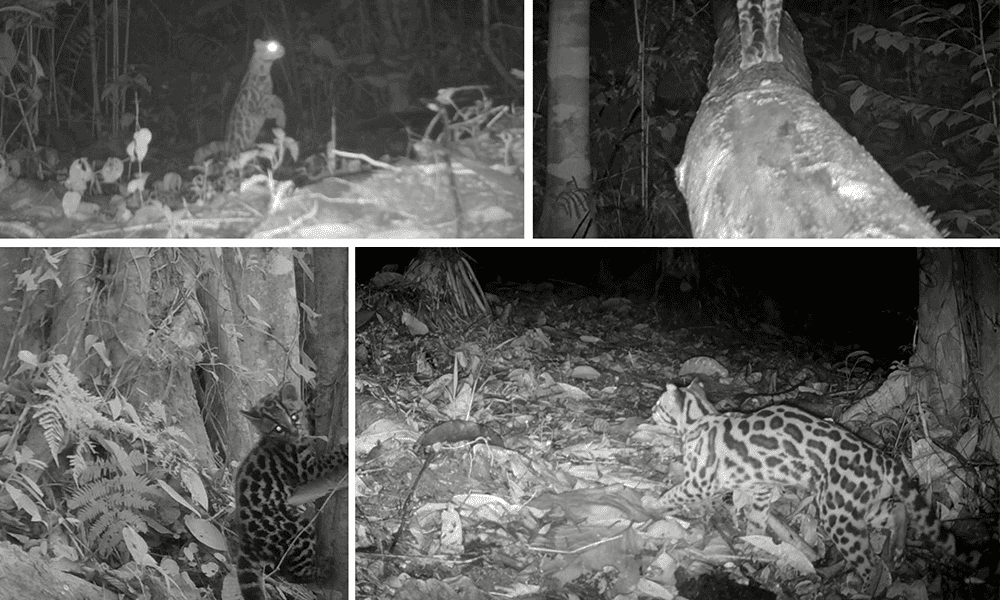The cat family is well represented in Costa Rica with six different species of felines calling the small country home. Throughout my years of attaching cameras to trees in Costa Rica, I’ve had varying degrees of interactions with each species. Here’s a list of each species in order of the frequency with which I see them or record them with my camera traps.
1. Ocelot

The ocelot (Leopardus pardalis) is by far and away the most common species of feline that I record with my camera traps. I’ve never had a camera trap project in any part of the country that didn’t record at least one of these medium-sized cats. Their varied diet and ability to adapt to different environments allows them to make nearly every corner of Costa Rica their home.
I must have hundreds of videos of ocelots with probably 90% of them being recorded at night. I’ve actually seen ocelots in the wild a few times as well with one notable interaction being a time when I peered into a big hole in the base of a tree and found a large male ocelot staring at me from inside. We were quite surprised to see each other.
2. Puma

Pumas (Puma concolor) are a distant second as far as the amount of captures I record with my camera traps. This is another species that lives throughout the entire country. They are actually the most widespread wildcat species on the planet, with a range that stretches from Canada down to the tip of South America.
I most frequently record pumas as a single individual, more often by day then by night, but sometimes I’ll record male and female pairs, or a female accompanied by some juveniles. I have yet to see a puma in person, but I wouldn’t be surprised if I’ve walked by one without ever knowing it was there.
3. Jaguarundi

There are plenty of reasons to love jaguarundis (Puma yagouaroundi). They come in a variety of colors from black to gray to orange. They have long, sleek bodies and heads that look confusingly like weasels. They’re also the most diurnal of Costa Rica’s cats, so most of my jaguarundi videos are during the day, which is always nice compared to black and white night videos.
I’ve recorded jaguarundis in different parts of the country in different types of forests. I’ve seen them twice in Guanacaste in interactions that were a combined four seconds. I saw an orange one dart across the trail I was walking on, and I saw a black one taking a drink from a pond before detecting my presence and disappearing into the brush.
4. Jaguar

Jaguars (Panthera onca) once roamed all of Costa Rica’s forests but are now limited to the wilder parts of the country, mostly in protected areas. Historically, most of my camera trap projects have been outside of the present-day range of jaguars, so I haven’t recorded a ton of them. Recently, I’ve started a camera trap tour in Horizontes (blatant self-promotion) where there are jaguars, so I’ve started recording a lot more jaguar videos.
Highlights of my recent jaguar recordings have been any video recorded during the day, so you can really appreciate the beauty of the coats and any videos of females with juveniles. I have never seen a jaguar in person and probably never will, but if I do, you’d better believe I’m writing a Tico Times article about it.
5. Margay

The margay (Leopardus wiedii) looks similar enough to an ocelot that sometimes it’s hard to determine what you’re looking at in a camera trap video. The literature states this species is located throughout Costa Rica, but in my experience, it is much less common than many of the other cats.
Margays are the most arboreal of Costa Rica’s cats so that could help explain why my mostly ground-level cameras aren’t recording them much. I’ve had one project that recorded a significant amount of margay videos, in a coffee farm called Aquiares, other than that they are a very infrequent capture on my camera traps.
6. Oncilla

For me, the oncilla (Leopardus tigrinus) is a complete mystery. This cat looks like somebody shrink-rayed a jaguar into a housecat-sized animal. They have the most limited range of any of the cats in Costa Rica, being confined to high altitude forests at the top of mountains.
I’m pretty sure that I have never set a camera trap within the range of the oncilla, which explains why I have zero oncilla videos. If I keep plugging away at this camera trap thing, someday I’ll have the opportunity to work in their range and finally record one.
About the Author
Vincent Losasso, founder of Guanacaste Wildlife Monitoring, is a biologist who works with camera traps throughout Costa Rica. Learn more about his projects on facebook or instagram. You can also email him at: vincent@guanacastewildlifemonitoring.com






